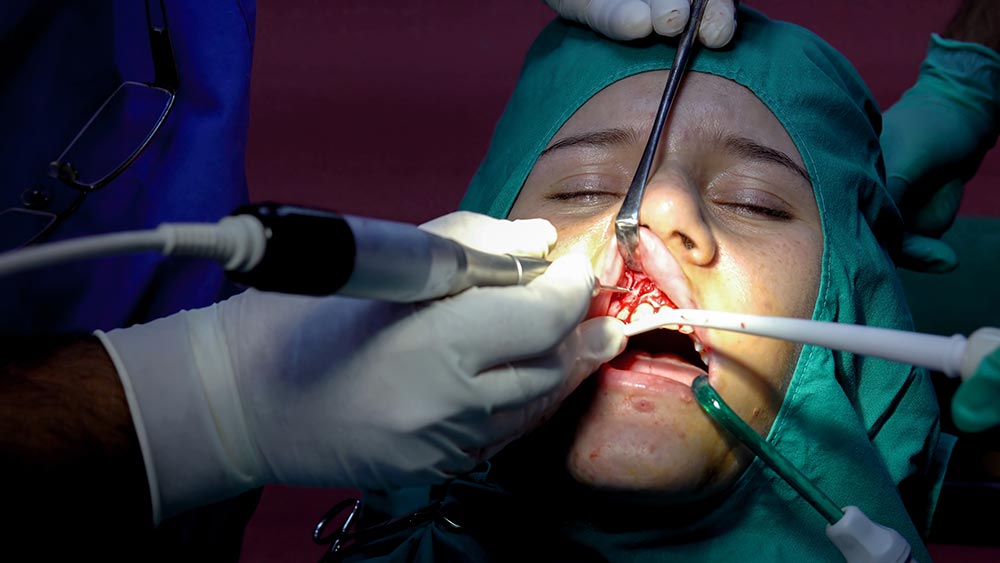Cyst surgery
Cyst surgery (cystectomy) is performed as part of oral or maxillofacial surgery and involves the surgical removal of a cyst of the hard or soft tissue of the oral cavity.
What are jaw cysts and how do they form?
Cysts of the jaws are growths of round or oval shape, filled with liquid or mucous content, and lined with a connective tissue sheath that is covered with epithelium. They are benign in nature and reach a size of several millimeters to several centimeters.
They can develop in any part of the upper or lower jaw, as well as in the soft tissue of the oral cavity (mucous membrane of the lips or cheeks), individually or as multiples. The main cause of their occurrence is considered to be untreated tooth inflammation, caused by pathogenic microorganisms from the caries lesion.
The bacteria that led to the formation of caries are transmitted through the root canal of the tooth to the pulp (nerve) and further to the apex (top of the tooth root). Inflammation of the tip of the tooth root (process) spreads to the surrounding bone and soft tissue, which leads to the formation of abscesses and phlegmon. If these inflammatory processes are not remedied, and the immune response of the organism is not satisfactory, cysts develop.
The formation of a cyst can also be congenital, i.e. related to a disorder in the development of the jaws and dentition (odontogenesis), and its hereditary character is also possible. Cysts are sometimes the result of periodontal disease or trauma to the teeth and jaws.
Cyst development rate
Cysts grow at different speeds and can destroy the jaw, i.e. lead to bone resorption or fracture. Also, they can endanger the teeth and maxillary sinus if they are localized in the upper jaw.
Cyst types, symptoms, and surgery
These pathological formations sometimes remain undetected for years because they do not produce any symptoms. Common signs and symptoms include:
- swelling;
- throbbing pain when chewing or at rest;
- discharge;
- stench;
- tooth discoloration;
- redness and swelling of the gums;
- tooth migration;
- elevated body temperature.
If the cysts are left untreated, they can lead to the development of infection, tooth loss, the aforementioned resorption of bone tissue and jaw fractures, and sometimes to the development of malignancy. Therefore, regular dental check-ups should be performed so that any changes are detected in time. This is particularly important from the aspect of preserving the volume of the jawbone.
Cyst surgery, that is, their complete removal, is a necessary procedure in order to prevent the mentioned negative consequences.

According to localization and pathogenesis, cysts are grouped into three types:
- radicular cyst;
- follicular cyst;
- keratocyst.
A radicular cyst is the most common cyst that develops in the jaws. It is of odontogenic origin and occurs around the root of gangrenous teeth, i.e. those with dead pulp. During the excision of this cyst, apicoectomy is usually performed in order not to save the tooth. If it is established that there are no conditions for preserving the tooth, a decision is made to extract it.
A follicular cyst belongs to the group of developmental cysts and occurs near the crown of an impacted tooth (upper canine or lower wisdom tooth). Sometimes with a supernumerary dental embryo. It is mostly asymptomatic and is detected by radiography during a regular examination.
Keratocyst is also a benign lesion of an odontogenic nature, which develops over a long period and shows a tendency towards recurrence if it is not completely removed. It usually affects the region of the lower third premolar, as well as the angle and ramus of the mandible.
Cyst surgery at Dr. Veselinović Dental Clinic
The diagnosis is established based on a clinical examination, medical history, and orthopantomography, made in our X-ray room. Treatment depends on the size of the cystic lesion, the degree of possible recurrence, and eventual perforation of the cortical bone, which is determined by X-ray.
Cyst surgery (cystectomy) means removal of the cyst in its entirety and is performed under local anesthesia. Cyst surgery includes several surgical methods such as following:
- incision and marsupialization (for larger cysts);
- enucleation with or without Carney’s solution (for smaller cysts);
- peripheral bone osteotomy;
- resection of the jawbone.
Choosing the type of cystectomy depends on the location, size, and pathohistology of the cyst. If it is about the enucleation of a follicular cyst, the procedure usually includes the extraction of the impacted tooth.
After the excision of the cyst, surgical closure of the defect with a mucosal flap and filling of the bone defect with a bone graft is performed. Sutures are removed on the seventh day after the operation, and antibiotic therapy is prescribed in the meantime.

In most cases, cyst surgery gives good results. The chances of infection and recurrence are minimized if the excision is performed completely.
Cysts should not be ignored. Regular visits to the dentist are the best way to detect and repair them in time and avoid complications.
